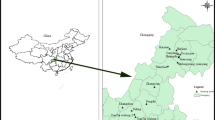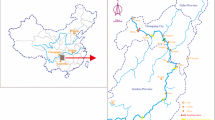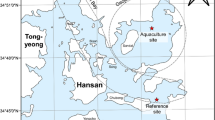Abstract
A survey was conducted in a freshwater reservoir located in Guizhou province, south China, to investigate the influence of fish aquaculture activities on mercury (Hg) distribution, speciation change, and bioaccumulation. Water, sediment, and aquaculture fish samples were collected from aquaculture sites (AS) and the corresponding reference sites (RS). The results showed that total mercury (THg) concentration in overlying water in Wujiangdu reservoir reached 6.87 ± 14.9 ng L−1. THg concentration in a different layer follows the sequence: surface layer > bottom layer > three intermediate layers with significant difference. In addition, the total methylmercury (TMeHg) concentration in overlying water was 0.113 ± 0.211 ng L−1. The highest TMeHg was observed in the bottom layer. Both dissolved Hg (DHg) and dissolved methylmercury (DMeHg) accounted for more than 50% of THg and TMeHg in the top four layers of overlying water, respectively. In contrast, particulate Hg (PHg) and particulate methylmercury were the major portion of THg and TMeHg in bottom layer and reached to 67 and 58.7% of THg and TMeHg, respectively. Aquaculture activities were estimated to contribute an annual loading of approximately 69.8 ng g−1of THg yearly in the top 1 cm of sediment underneath the rafts due to unconsumed fish feed. The extra loading of THg in sediment may have potential to stimulate the release of Hg to the overlying water. Both DMeHg and DHg in sediment pore water and organic matter (OM) contents in the top 4 cm of AS were noticeably higher than RS, which indicated that the accumulation of OM due to aquaculture activities promoted MeHg production in the top surface of sediment pore water. No significant difference was noted between THg in RS (296 ± 104 ng g−1) and AS (274 ± 132 ng g−1) in the solid phase. In addition, the sediments were net sources of both MeHg and inorganic Hg. For Hg in fish tissues, THg and inorganic Hg (IHg) in the liver were significantly higher (THg: p < 0.001, F = 9.98; IHg: p < 0.001, F = 13.1) than those in the other organs. In contrast, MeHg concentration in the muscle was significantly higher than (p < 0.01, F = 4.83) that in the other organs.




Similar content being viewed by others
References
Bloom N, Fitzgerald WF (1988) Determination of volatile mercury species at the picogram level by low-temperature gas chromatography with cold-vapour atomic fluorescence detection. Anal Chim Acta 208:151–161
Bloom NS (1992) On the chemical form of mercury in edible fish and marine invertebrate tissue. Can J Fish Aquat Sci 49:1010–1017
Boudreau BP (1996) The diffusive tortuosity of fine-grained unlithified sediments. Geochim Cosmochim Acta 60:3139–3142
Cossa D, Gobeil C (2000) Mercury speciation in the Lower St. Lawrence Estuary. Can J Fish Aquat 57:138–147
Covelli S, Faganeli J, De Vittor C, Predonzani S, Acquavita A, Horvat M (2008) Benthic fluxes of mercury species in a lagoon environment (Grado Lagoon, Northern Adriatic Sea, Italy). Appl Geochem 23:529–546
Downs SG, MacLeod CL, Lester JN (1998) Mercury in precipitation and its relation to bioaccumulation in fish: a literature review. Water Air Soil Pollut 108:149–187
Driscoll CT, Mason RP, Chan HM, Jacob DJ, Pirrone N (2013) Mercury as a global pollutant: sources, pathways, and effects. Environ Sci Technol 47:4967–4983
Eagles-Smith CA, Ackerman JT, Yee J, Adelsbach TL (2009) Mercury demethylation in waterbird livers: dose–response thresholds and differences among species. Environ Toxicol Chem 28, 568–577
FAO (2014): Fishery and aquaculture statistics. Food and agriculture organization of the United Nations Rome
FAO (2004) The state of world fisheries and aquaculture. In: Department F (ed) Food and Agriculture Organization of the United Nation, Rome: Italy, pp 1–153
Feng X, Jiang H, Qiu G, Yan H, Li G, Li Z (2009a) Geochemical processes of mercury in Wujiangdu and Dongfeng reservoirs, Guizhou, China. Environ Pollut 157:2970–2984
Feng X, Jiang H, Qiu G, Yan H, Li G, Li Z (2009b) Mercury mass balance study in Wujiangdu and Dongfeng reservoirs, Guizhou, China. Environ Pollut 157:2594–2603
Gonzalez P, Dominique Y, Massabuau JC, Boudou A, Bourdineaud JP (2005) Comparative effects of dietary methylmercury on gene expression in liver, skeletal muscle, and brain of the zebrafish (Danio rerio). Environ Sci Technol 39, 3972–3980
Hammerschmidt CR, Fitzgerald WF, Balcom PH, Visscher PT (2008) Organic matter and sulfide inhibit methylmercury production in sediments of New York/New Jersey Harbor. Mar Chem 109:165–182
Harris HH, Pickering IJ, George GN (2003) The chemical form of mercury in fish. Science 301:1203
HKAFCD (2009) Fish feed management, good aquaculture practices series 1. In: Hong Kong Agriculture FaCD (ed) Hong Kong
Khwaja AR, Bloom PR, Brezonik PL (2006) Binding constants of divalent mercury (Hg2+) in soil humic acids and soil organic matter. Environ Sci Technol 40:844–849
Klinck J, Dunbar M, Brown S, Nichols J, Winter A, Hughes C, Playle RC (2005) Influence of water chemistry and natural organic matter on active and passive uptake of inorganic mercury by gills of rainbow trout (Oncorhynchus mykiss). Aquat Toxicol 72:161–175
Lerman A (1979) Geochemical Processes –Water and Sediment Environments. John Wiley and Sons, New York
Liang L, Horvat M, Bloom NS (1994) An improved speciation method for mercury by GC/CVAFS after aqueous phase ethylation and room temperature precollection. Talanta 41:371–379
Liang P, Shao D-D, Wu S-C, Shi J-B, Sun X-l WF-Y, Lo SCL, Wang W-X, Wong MH (2011) The influence of mariculture on mercury distribution in sediments and fish around Hong Kong and adjacent mainland China waters. Chemosphere 82:1038–1043
Liang P, Wu S-C, Li Y-C, Li H-B, Yu G-b YS, Wong MH (2012) The effects of mariculture activities on the adsorption/desorption and chemical fractionations of mercury on sediments. Mar Pollut Bull 64:836–843
Liang P, Lam C-L, Chen Z, Wang H-S, Shi J-B, Wu S-C, Wang W-X, Zhang J, Wang H, Wong M-H (2013) Formation and distribution of methylmercury in sediments at a mariculture site: a mesocosm study. J Soils Sediments 13:1301–1308
Liang P, Gao X-F, You Q-Z, Zhang J, Cao Y-C, Zhang C, Wong M-H, Wu S-C (2016) Role of mariculture in the loading and speciation of mercury at the coast of the East China Sea. Environ Pollut 218:1037–1044
Luo, J-X, Xu H-Y, Sun X-C, Tang Z-B, Li N, Lu B (2011): Impact of Reservoir Cage Culture on Environment & Countermeasures Research at Wujiangdu Hydropower Station. Guizhou Water Power 25, 36–38 (in Chinese)
Mason PR, Laporte J-M, Andres S (2000) Factors controlling the bioaccumulation of mercury, methylmercury, arsenic, selenium, and cadmium by freshwater invertebrates and fish. Arch Environ Contam Toxicol 38:283–297
Mason RP, Reinfelder JR, Morel FMM (1995a) Bioaccumulation of mercury and methylmercury. In: Porcella DB, Huckabee JW, Wheatley B (Eds) Mercury as a Global Pollutant: Proceedings of the Third International Conference held in Whistler, British Columbia, July 10–14, 1994. Springer Netherlands, Dordrecht, pp 915–921
Mason RP, Reinfelder JR, Morel FMM (1995b) Bioaccumulation of mercury and methylmercury. Water Air Soil Pollut 80:915–921
Meng B, Feng XB, Chen CX, Qiu GL, Sommar J, Guo YN, Liang P, Wan Q (2010) Influence of eutrophication on the distribution of total mercury and methylmercury in hydroelectric reservoirs. J Environ Qual 39
Meng B, Feng X, Qiu G, Li Z, Yao H, Shang L, Yan H (2016) The impacts of organic matter on the distribution and methylation of mercury in a hydroelectric reservoir in Wujiang River, Southwest China. Environ Toxicol Chem 35:191–199
Mergler D, Anderson HA, Chan LHM, Mahaffey KR, Murray M, Sakamoto M, Stern AH (2007) Methylmercury exposure and health effects in humans: a worldwide concern. Ambio 36:3–11
Mieiro CL, Pacheco M, Pereira ME, Duarte AC (2009) Mercury distribution in key tissues of fish (Liza aurata) inhabiting a contaminated estuary-implications for human and ecosystem health risk assessment. J Environ Monit 11:1004–1012
Oken E, Wright RO, Kleinman KP, Bellinger D, Amarasiriwardena CJ, Hu H, Rich-Edwards JW, Gillman MW (2005) Maternal fish consumption, hair mercury, and infant cognition in a U.S. cohort. Environ Health Perspect 113:1376–1380
Sapkota A, Sapkota AR, Kucharski M, Burke J, McKenzie S, Walker P, Lawrence R (2008) Aquaculture practices and potential human health risks: current knowledge and future priorities. Environ Int 34:1215–1226
Shao D, Liang P, Kang Y, Wang H, Cheng Z, Wu S, Shi J, Lo SCL, Wang W, Wong MH (2011) Mercury species of sediment and fish in freshwater fish ponds around the Pearl River Delta, PR China: human health risk assessment. Chemosphere 83:443–448
Subasinghe R, Soto D, Jia J (2009) Global aquaculture and its role in sustainable development. Rev Aquac 1:2–9
Sun JL, Zhong X, Liu YX, Fu J (2005) Th e status analysis of cage culture fi shing of reservoir and lake in Guizhou province. Guizhou Environ Protect Sci Technol 11:30–34 (in Chinese)
Ullrich SM, Tanton TW, Abdrashitova SA (2001) Mercury in the aquatic environment: a review of factors affecting methylation. Crit Rev Environ Sci Technol 31:241–293
UNEP (2013) Sources, emissions. Releases and Environmental Transport, Geneva
USEPA (2001) Methyl mercury in water by distillation, aqueous ethylation, purge and trap, and CVAFS (Method 1630). In: USEPA (ed) Washington, DC
USEPA (2002) Mercury in water by oxidation, purge and trap, and cold vapor atomic fluorescence spectrometry (Method 1631, revision E). In: USEPA (ed) Washington, DC
Yin YG, Li YB, Ma X, Liu JF, Jiang GB (2013) Role of natural organic matter in the biogeochemical cycle of mercury : binding and molecular transformation. Prog Chem 25:2169–2177
Zhao K-Y (2016): Study on mercury pollution in mariculture areas around the Pearl River Estuary and risk assessment of mercury exposure. Thesis. Peking University. 52-53
Acknowledgements
Financial support from the Innovative Team Foundation of Zhejiang Province (2013TD12), the National Natural Science Foundation of China (No. 21577130), and Zhejiang Provincial Public Techniques Research and Social Development Project (2015C33050) are gratefully acknowledged. We would also like to thank the support of the Innovation Technology Fund (ITS/174/14FX) for visiting the Education University of Hong Kong.
Author information
Authors and Affiliations
Corresponding authors
Additional information
Responsible editor: Philippe Garrigues
Appendix
Appendix
Rights and permissions
About this article
Cite this article
Liang, P., Feng, X., You, Q. et al. The effects of aquaculture on mercury distribution, changing speciation, and bioaccumulation in a reservoir ecosystem. Environ Sci Pollut Res 24, 25923–25932 (2017). https://doi.org/10.1007/s11356-017-0189-6
Received:
Accepted:
Published:
Issue Date:
DOI: https://doi.org/10.1007/s11356-017-0189-6




